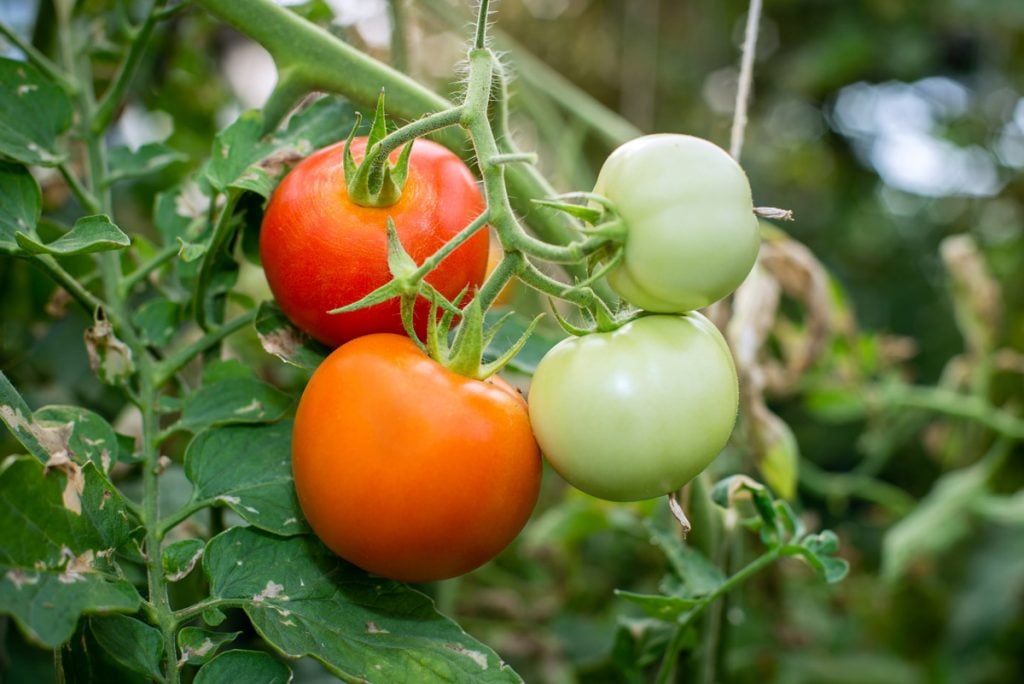There is nothing like fresh garden tomatoes for a flavor burst of sweet goodness. When you make freeze dried tomatoes, they taste just like fresh to use in your favorite pasta sauce recipe or pizza, soup, stew, and more! In just a few minutes of hands-on work, you can line your shelves with diced tomatoes, tomato sauce or tomato paste.

Why I Love Freeze Dried Tomatoes
Tomatoes are a crop that won’t survive a frost. We are growing tomatoes in a colder climate, so there are times at the end of the growing season when we are harvesting several bushels at a time. Everything must come off the vine, and if they aren’t fully ripe, we will ripen green tomatoes indoors.
Our goal is to put up enough tomatoes to last until the next growing season, so fermented tomatoes, dehydrated tomatoes and canned tomatoes will all be found in our pantry. However, now that I’ve discovered just how easy freeze drying tomatoes is, I can tell you I won’t be canning them again!
The preparation time to freeze dry tomatoes is less demanding. I don’t need to slice them, blanch them, then shock them in ice water just to remove the skin; I simply dice them quicky in the food processor, dump them onto the trays and let the Harvest Right Freeze Dryer do the rest (check out my review of the Harvest Right Freeze Dryer here).
The convenience the freeze dryer has offered leads me back to choosing freeze drying as a preferred food preservation method time and time again.
Not only do we freeze dry vegetables like corn from our garden, but we also have freeze dried herbs, freeze dried eggs, freeze dried milk, and even freeze dried coffee. The options are truly endless!

Ways to Use Freeze Dried Tomatoes
Freeze dried tomatoes are excellent in cooked or fresh recipes. The way we preserve them, they’re simple to use as a jar of canned diced tomatoes, tomato sauce or even tomato paste:
- Diced Tomatoes – To make the equivalent of a jar of diced tomatoes, simply add boiling water to the pint-sized Mason jar until the water reaches the lower part of the rim. Give them a few minutes to reconstitute and use as a jar (or can) of diced tomatoes.
- Tomato Sauce – To turn your freeze dried tomatoes into tomato sauce, simply smash the freeze dried tomatoes with a wooden spoon or your fingers (or powder them in the food processor) and add boiling water to the pint-sized Mason jar until the water reaches the lower part of the rim. Wait a few minutes, then give it a stir to make sure everything has been reconstituted with the water.
- Tomato Paste – Making tomato paste couldn’t be easier. No more sitting over the stove for hours waiting for your tomato sauce to reduce. Simply powder the freeze dried tomatoes in a food processor, then add just enough boiling water to create a paste. Wait a few minutes, give it a stir and adjust as needed.
If you’re wondering if there are more ways to enjoy freeze dried tomatoes, the answer is YES:
- Sandwiches – To some, the texture of reconstituted freeze dried tomato slices can be mealy, but I’ve also read that people love putting freeze dried tomato slices right on their sandwiches, allowing them to soften slightly just with the juices in the sandwich. You be the judge!
- Sauces, Soups, and Stews – Depending on the variety, you can add freeze dried diced tomatoes to soups, chili, and stews (like this Hoover Stew). The tomatoes reconstitute in the liquid for a fresh garden flavor.
- Pizza and Red Sauces – Fresh sliced garden tomatoes are great in these pizza poppers or as a pizza topping on homemade sourdough pizza. But freeze dried tomatoes reconstituted with spices, onions, and garlic make a quick and easy marinara or spaghetti and meat sauce.
- Tomato Powder – Once the tomatoes are freeze dried, you can quickly grind them into a powder. The intense flavor is delicious! Sprinkle it on popcorn made with olive oil, and use it in a homemade vinaigrette dressing or use a pinch to season scrambled eggs.

The Best Tomatoes for Freeze Drying
Tomatoes of all varieties, shapes and sizes can be freeze dried. If a good marinara or pizza sauce is what you’re looking for, use tomatoes with a low water content, like San Marzano or a meatier tomato with fewer seeds, like Roma’s.
You can’t beat cherry tomato varieties such as Sun Gold or Black Cherry that yield a sweet treat. They are quick to prepare and easy to freeze dry with or without seasonings. Homesteading Hack: Be sure to slice them in half or poke them prior to freeze drying so they don’t burst. You can try using this tool meant for piercing berries.

Preparing Tomatoes for Freeze Drying
All preserved foods need proper preparation, and tomatoes for freeze drying are no exception. These tips will give you delicious freeze dried tomatoes with little effort.
- Wash Thoroughly – It’s important to wash your tomatoes and remove any dirt, insects or other debris, especially if it’s picked fresh from your garden. Freeze dried dirt and insects can introduce mold, fungus and any other unwanted bacteria to the food.
- Dry Thoroughly – I recommend drying the tomatoes well. The freeze drying process removes water from the fruit; the more water left on it, the longer it will take to freeze dry.
- De-stem – Remove the stems from all tomato varieties before freeze drying for best results. There is no need to remove the skin or the core; they freeze dry well.
- Remove Blemishes – Use a paring knife to remove any blemishes, insect holes or spots.

Supplies Needed
- Freeze Dryer – I use and highly recommend the Harvest Right Freeze Dryer. I like it so much that we now operate two for all the freeze drying we do for our large family.
- Sharp Knives – A clean, sharp paring knife makes quick work of de-stemming and removing blemishes, while a serrated knife works well when slicing the tomatoes. Homesteading Hack: Food processors are functional kitchen tools that dice tomatoes quickly and efficiently. I prefer this Breville food processor because of its 16-cup capacity, along with the Breville dicing kit, but any processor with sharp blades will work well.
- Cutting Board – A clean cutting board with a non-slip surface works well when slicing or dicing tomatoes.
- Towels or Paper Towels – Dry the tomatoes thoroughly with a kitchen towel or paper towel.
- Storage Containers – The best way to store freeze dried tomatoes is in vacuum-sealed glass jars or Mylar bags with oxygen absorbers. I prefer pint-sized glass jars if I know I’ll be using them 1:1 for store-bought tomato products, otherwise we use half-gallon Mason jars.
- Silicone Mats – We prefer these silicone freeze dryer mats instead of one-time-use parchment paper. Though parchment paper will also work if that’s all you have. If you don’t want the tomatoes to stick to the trays, I recommend lining your trays.
- Vacuum Sealer – I recommend a vacuum sealer tool to remove as much air as possible from the containers in which you store your freeze dried tomatoes for future use. I have used this jar sealer attachment for years, but I recently started using this rechargeable jar sealer, and it works great.
- Labels and Pens – It’s a good idea to mark the date and contents, especially if you store them in Mylar bags. Homesteading Hack: Record the type of tomatoes you freeze dried for a quick reference when making a sauce or adding diced tomatoes to a recipe.

Ingredients Needed
- Tomatoes – Your tomatoes should be clean and dry with stems and blemishes removed; prepared how you want to use them (sliced, diced or pureed).
- Herbs – Herbs are optional if you want to sprinkle chopped fresh or dried herbs on top of the tomatoes before freeze drying them. Homesteading Hack: I recommend not using salt on the tomatoes before freeze drying. In my experience, it concentrates the flavors, diminishing the authentic, fresh tomato flavor.
- Salt (optional) – Some people like to omit the salt, choosing rather to season later on. But if you’d like your freeze dried tomatoes to be ready to eat, you may want to add a sprinkle of salt. We only use Redmond Real Salt here on the homestead. Use coupon code “HFSalt” at checkout for 15% off your order.



How to Freeze Dry Tomatoes
- The newer freeze dryers no longer have a “not frozen” option. After years of use, I’ve found I pretty much pre-freeze everything now. Pre-freeze the tomatoes for 24 hours before freeze drying. These tray stackers come in real handy when freezing multiple trays at a time.
- Once your tomatoes are frozen, turn the machine on and select the customize button. Increase the Additional Dry Time to 12 hours. Homesteading Hack: This is necessary because of the seeds (the hard shell locks in moisture that can ruin your tomatoes in storage).
- If preferred, line your dryer trays with parchment paper or a silicone mat to prevent sticking. Cherry tomatoes’ natural sugars may bubble out (looks like a white foam) and stick to the tray without parchment paper.
- Slice, dice or puree the tomatoes. Make sure they are not more than ½” inch thick when slicing. Cut the cherry tomatoes in half; if they are extra large, cut them in quarters with your knife.
- Place the tomatoes on the trays, with space between each slice. If diced, separate as best as possible and avoid stacking for the best freeze dried results. If pureed, place the trays into the freeze dryer before pouring the tomato puree onto the trays. This helps avoid spilling! Spread the puree evenly on the sheets to ensure even freeze drying.
- Add the trays to the freeze drier and set the recommended time for your appliance. The Harvest Right Freeze dryer has a beeper that alerts you when the food is properly freeze dried.
- If more time is needed, pop the tray back in and set it for another 1-2 hours. Be aware that the seeds in tomatoes take longer to freeze dry thoroughly, and more time may be needed.



How to Tell If Freeze Dried Tomatoes Are Done
The best way to tell if your tomatoes are fully freeze dried is to break them into pieces and see if moisture is still present. The tomatoes should not be cold to the touch, and there should be no gumminess.
Sliced and diced tomatoes will be crunchy. Pureed tomatoes or tomato sauce will crumble easily into a powder when fully freeze dried and rubbed between your fingers.

How to Rehydrate Freeze Dried Tomatoes
The technical way to reconstitute your tomatoes is to weigh the tray before freeze drying and then weigh it again after freeze drying; the difference in weight is how much water would need to be added back to the entire tray to rehydrate them.
Divide this number by the servings on each tray to reconstitute one serving at a time.
If you didn’t weigh your trays, here are some ideas for reconstituting tomatoes:
- Soups & Stews – When making stew, soup or chilis, toss them in the pot and let the juices or stock rehydrate them quickly.
- Paste & Sauce – If you want to make a paste or sauce out of them, toss them in a blender or food processor with increments of water until it’s the consistency you want.
- Pizza – Topping pizza with sliced tomatoes? Soak them in a bowl of warm water until hydrated, blot dry, and top the pizza and bake.
Slowly add small amounts of liquid when making pastes or sauces. It really is simple and easy to rehydrate and use quickly for your favorite recipes.

How to Store Freeze Dried Tomatoes
Protect all freeze dried food from direct sunlight, moisture, and oxygen. When stored correctly, freeze dried tomatoes have a shelf life of up to 25 years. This is never our goal, and we aim to line our shelves with enough freeze dried tomatoes to last two years (in case we have a poor tomato crop the following year).
Use Mylar bags or vacuum-sealed Mason jars for food storage. Be sure to label and date the container. Since oxygen causes faster spoilage, we recommend adding an oxygen absorber and resealing the jars with a vacuum-sealer after each time you open them.
Did you try freeze drying tomatoes? If so, please leave a star rating in the recipe card below, then snap a photo of how you’re using your freeze dried tomatoes and tag us on social media @homesteadingfamily so we can see!

Becoming a Freeze Drying Master
Did you know that when it comes to freeze drying, every food is unique and can have minor differences that either make or break your success?
In my book Freeze Drying the Harvest: Preserving Food the Modern Way
I’ve included specific, detailed guidance on how to freeze dry all your foods properly.
I’ve covered all the things I wish I knew when I first started freeze drying, like…
- Why you should be freeze drying
- How to choose the right freeze dryer
- How to set up your freeze dryer
- How much it actually costs to run a freeze dryer
- How to maintain your freeze dryer
- What other equipment you really need (or don’t)
- Which foods you can freeze dry
- Which foods you cannot freeze dry
- Food safety with freeze drying
- How to rehydrate your freeze dried foods
Is learning easier when you have video visuals to guide you through the process step-by-step? Then, my Freeze Drying Masterclass has you covered!
These resources can be purchased separately or as companions, so whether you choose the book or the masterclass, you will receive all the information I wished I had when I first began my freeze drying journey.



















